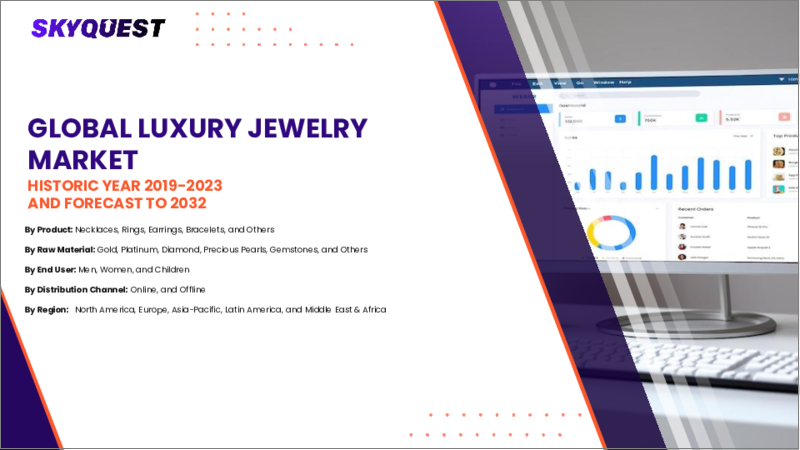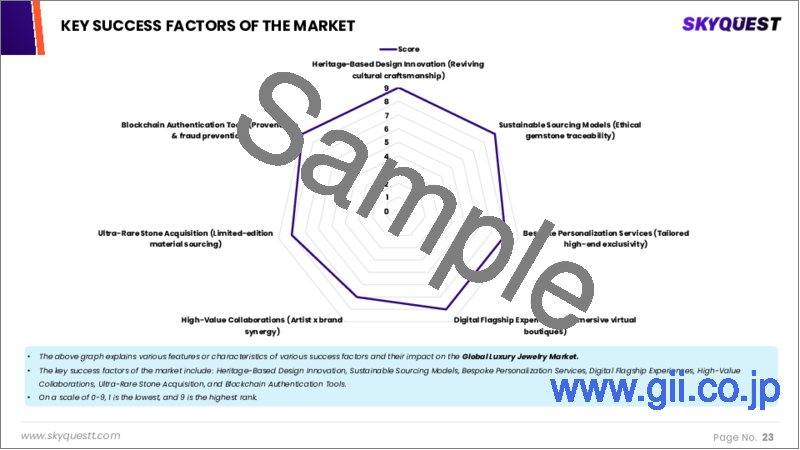|
|
市場調査レポート
商品コード
1643834
高級宝飾品の市場規模、シェア、成長分析:タイプ別、原材料別、流通チャネル別、最終用途別、地域別 - 産業予測 2025年~2032年Luxury Jewelry Market Size, Share, Growth Analysis, By Type (Necklaces, Ring), By Raw Material (Gold, Platinum), By Distribution Channel, By End Use, By Region - Industry Forecast 2025-2032 |
||||||
|
|||||||
| 高級宝飾品の市場規模、シェア、成長分析:タイプ別、原材料別、流通チャネル別、最終用途別、地域別 - 産業予測 2025年~2032年 |
|
出版日: 2025年01月22日
発行: SkyQuest
ページ情報: 英文 314 Pages
納期: 3~5営業日
|
- 全表示
- 概要
- 目次
高級宝飾品の市場規模は2023年に612億米ドルと評価され、2024年の659億7,000万米ドルから2032年には1,203億2,000万米ドルに成長し、予測期間(2025-2032年)のCAGRは7.8%で成長する見通しです。
高級宝飾品市場は、貴金属や宝石で作られた高品質な作品が特徴で、近代化、西洋化、可処分所得の増加によって力強い成長を遂げています。この拡大を後押ししている主な要因としては、豪華な商品に対する消費者の嗜好の高まり、ジュエリーのデザインと製造の進歩、ファッションジュエリーの動向の急増などが挙げられます。ブランドジュエリーの人気が高まるにつれ、メーカーは高級品の供給力を高めることで対応しています。さらに、テレビマーケティングの増加や、儀式におけるジュエリーの使用の増加は、長期的な市場拡大の機会を提供する態勢を整えています。さらに、消費者の占星術への関心の高まりは、高級アパレル分野にプラスの影響を与え、高級宝飾品の展望にさらなる成長の道をもたらすと予想されます。
目次
イントロダクション
- 調査の目的
- 調査範囲
- 定義
調査手法
- 情報調達
- 二次データと一次データの方法
- 市場規模予測
- 市場の前提条件と制限
エグゼクティブサマリー
- 世界市場の見通し
- 供給と需要の動向分析
- セグメント別機会分析
市場力学と見通し
- 市場概要
- 市場規模
- 市場力学
- 促進要因と機会
- 抑制要因と課題
- ポーターの分析
主な市場の考察
- 重要成功要因
- 競合の程度
- 主な投資機会
- 市場エコシステム
- 市場の魅力指数(2024年)
- PESTEL分析
- マクロ経済指標
- バリューチェーン分析
- 価格戦略分析
- 規制情勢
- ケーススタディ
- 貿易分析
- 消費者購買行動分析
- 原材料の分析
高級宝飾品市場規模:タイプ別& CAGR(2025-2032)
- 市場概要
- ネックレス
- 指輪
- イヤリング
- ブレスレット
- その他
高級宝飾品市場規模:原材料別& CAGR(2025-2032)
- 市場概要
- 金
- 白金
- ダイヤモンド
- 貴重な真珠
- 宝石
- その他
高級宝飾品市場規模:流通チャネル別& CAGR(2025-2032)
- 市場概要
- オフライン
- オンライン
高級宝飾品市場規模:最終用途別& CAGR(2025-2032)
- 市場概要
- 女性
- 男性
- 子供
高級宝飾品市場規模:地域別& CAGR(2025-2032)
- 北米
- 米国
- カナダ
- 欧州
- ドイツ
- スペイン
- フランス
- 英国
- イタリア
- その他欧州地域
- アジア太平洋地域
- 中国
- インド
- 日本
- 韓国
- その他アジア太平洋地域
- ラテンアメリカ
- ブラジル
- その他ラテンアメリカ地域
- 中東・アフリカ
- GCC諸国
- 南アフリカ
- その他中東・アフリカ
競合情報
- 上位5社の比較
- 主要企業の市場ポジショニング(2024年)
- 主な市場企業が採用した戦略
- 市場の最近の動向
- 企業の市場シェア分析(2024年)
- 主要企業の企業プロファイル
- 会社概要
- 製品ポートフォリオ分析
- セグメント別シェア分析
- 収益の前年比比較(2022-2024)
主要企業プロファイル
- Tiffany & Co.(United States)
- Graff(United Kingdom)
- Mikimoto(Japan)
- Chopard(Switzerland)
- Harry Winston(United States)
- Van Cleef & Arpels(France)
- Boucheron(France)
- Piaget(Switzerland)
- David Yurman(United States)
- Buccellati(Italy)
- Mouawad(Lebanon)
- Mauboussin(France)
- De Grisogono(Switzerland)
- Repossi(Italy)
- Cartier(France)
- Bulgari(Italy)
- Chaumet(France)
- Messika(France)
- Damiani(Italy)
- Swarovski(Austria)
結論と推奨事項
Luxury Jewelry Market size was valued at USD 61.2 billion in 2023 and is poised to grow from USD 65.97 billion in 2024 to USD 120.32 billion by 2032, growing at a CAGR of 7.8% during the forecast period (2025-2032).
The luxury jewelry market, characterized by high-quality pieces made from precious metals and stones, is experiencing robust growth driven by modernization, westernization, and rising disposable incomes. Key factors fueling this expansion include a heightened consumer preference for opulent goods, advancements in jewelry design and production, and the surge of fashion jewelry trends. As branded jewelry gains popularity, manufacturers are responding by enhancing the availability of luxury products. Furthermore, increased television marketing and the growing use of jewelry in ceremonies are poised to present long-term opportunities for market expansion. Additionally, the rising consumer interest in astrology is expected to positively impact the luxury apparel sector, creating additional avenues for growth within the luxury jewelry landscape.
Top-down and bottom-up approaches were used to estimate and validate the size of the Luxury Jewelry market and to estimate the size of various other dependent submarkets. The research methodology used to estimate the market size includes the following details: The key players in the market were identified through secondary research, and their market shares in the respective regions were determined through primary and secondary research. This entire procedure includes the study of the annual and financial reports of the top market players and extensive interviews for key insights from industry leaders such as CEOs, VPs, directors, and marketing executives. All percentage shares split, and breakdowns were determined using secondary sources and verified through Primary sources. All possible parameters that affect the markets covered in this research study have been accounted for, viewed in extensive detail, verified through primary research, and analyzed to get the final quantitative and qualitative data.
Luxury Jewelry Market Segments Analysis
Global Luxury Jewelry Market is segmented by Type, Raw Material, Distribution Channel, End Use and region. Based on Type, the market is segmented into Necklaces, Ring, Earrings, Bracelets and Others. Based on Raw Material, the market is segmented into Gold, Platinum, Diamond, Precious Pearls, Gemstones and Others. Based on Distribution Channel, the market is segmented into Offline and Online. Based on End Use, the market is segmented into Women, Men and Children. Based on region, the market is segmented into North America, Europe, Asia Pacific, Latin America and Middle East & Africa.
Driver of the Luxury Jewelry Market
The luxury jewelry market is experiencing significant growth, driven primarily by rising disposable incomes, which are allowing consumers to invest more in premium products. As people gain greater financial freedom, the demand for luxury jewelry increases, particularly in countries with deep-rooted traditions surrounding precious metals like gold and silver, such as India. Additionally, the influence of globalization and digital media plays a crucial role in driving market trends. Access to information about evolving fashion trends through online platforms has heightened consumer interest in luxury jewelry. For example, the recent surge in popularity of East Asian street fashion reflects this growing trend, further contributing to the market's anticipated expansion.
Restraints in the Luxury Jewelry Market
The luxury jewelry market faces several significant restraints that hinder its growth. High tariffs and indirect taxes on the import and export of precious metals and jewelry lead to increased prices of finished products, causing potential buyers to reconsider purchasing luxury items. Additionally, the global uneven distribution of precious metals necessary for high-end jewelry limits availability. Political tensions among nations further restrict the movement of luxury goods across borders. The pandemic-related lockdowns exacerbated these issues, halting mining operations and causing a complete market shutdown. As consumer priorities shifted from luxury purchases to essential goods, the demand for expensive jewelry declined, compounded by disrupted distribution networks that impeded imports and exports.
Market Trends of the Luxury Jewelry Market
As we look ahead, the luxury jewelry market is poised for significant growth, largely driven by an increasing demand for men's jewelry. Historically dominated by female consumers, the segment is witnessing a shift as men prioritize aesthetic appeal and self-grooming. This transformation is further accelerated by social media's influence, encouraging men to embrace contemporary fashion trends, including luxury adornments. Consequently, items such as necklaces, bracelets, and rings designed for men are gaining popularity, prompting manufacturers to innovate and diversify their offerings. This emerging market trend not only reflects evolving consumer behavior but also invites brands to strategically align their products to capture this lucrative demographic.
Table of Contents
Introduction
- Objectives of the Study
- Scope of the Report
- Definitions
Research Methodology
- Information Procurement
- Secondary & Primary Data Methods
- Market Size Estimation
- Market Assumptions & Limitations
Executive Summary
- Global Market Outlook
- Supply & Demand Trend Analysis
- Segmental Opportunity Analysis
Market Dynamics & Outlook
- Market Overview
- Market Size
- Market Dynamics
- Drivers & Opportunities
- Restraints & Challenges
- Porters Analysis
- Competitive rivalry
- Threat of substitute
- Bargaining power of buyers
- Threat of new entrants
- Bargaining power of suppliers
Key Market Insights
- Key Success Factors
- Degree of Competition
- Top Investment Pockets
- Market Ecosystem
- Market Attractiveness Index, 2024
- PESTEL Analysis
- Macro-Economic Indicators
- Value Chain Analysis
- Pricing Strategy Analysis
- Regulatory Landscape
- Case Studies
- Trade Analysis
- Consumer Buying Behaviour Analysis
- Raw Material Analysis
Global Luxury Jewelry Market Size by Type & CAGR (2025-2032)
- Market Overview
- Necklaces
- Ring
- Earrings
- Bracelets
- Others
Global Luxury Jewelry Market Size by Raw Material & CAGR (2025-2032)
- Market Overview
- Gold
- Platinum
- Diamond
- Precious Pearls
- Gemstones
- Others
Global Luxury Jewelry Market Size by Distribution Channel & CAGR (2025-2032)
- Market Overview
- Offline
- Online
Global Luxury Jewelry Market Size by End Use & CAGR (2025-2032)
- Market Overview
- Women
- Men
- Children
Global Luxury Jewelry Market Size & CAGR (2025-2032)
- North America (Type, Raw Material, Distribution Channel, End Use)
- US
- Canada
- Europe (Type, Raw Material, Distribution Channel, End Use)
- Germany
- Spain
- France
- UK
- Italy
- Rest of Europe
- Asia Pacific (Type, Raw Material, Distribution Channel, End Use)
- China
- India
- Japan
- South Korea
- Rest of Asia-Pacific
- Latin America (Type, Raw Material, Distribution Channel, End Use)
- Brazil
- Rest of Latin America
- Middle East & Africa (Type, Raw Material, Distribution Channel, End Use)
- GCC Countries
- South Africa
- Rest of Middle East & Africa
Competitive Intelligence
- Top 5 Player Comparison
- Market Positioning of Key Players, 2024
- Strategies Adopted by Key Market Players
- Recent Developments in the Market
- Company Market Share Analysis, 2024
- Company Profiles of All Key Players
- Company Details
- Product Portfolio Analysis
- Company's Segmental Share Analysis
- Revenue Y-O-Y Comparison (2022-2024)
Key Company Profiles
- Tiffany & Co. (United States)
- Company Overview
- Business Segment Overview
- Financial Updates
- Key Developments
- Graff (United Kingdom)
- Company Overview
- Business Segment Overview
- Financial Updates
- Key Developments
- Mikimoto (Japan)
- Company Overview
- Business Segment Overview
- Financial Updates
- Key Developments
- Chopard (Switzerland)
- Company Overview
- Business Segment Overview
- Financial Updates
- Key Developments
- Harry Winston (United States)
- Company Overview
- Business Segment Overview
- Financial Updates
- Key Developments
- Van Cleef & Arpels (France)
- Company Overview
- Business Segment Overview
- Financial Updates
- Key Developments
- Boucheron (France)
- Company Overview
- Business Segment Overview
- Financial Updates
- Key Developments
- Piaget (Switzerland)
- Company Overview
- Business Segment Overview
- Financial Updates
- Key Developments
- David Yurman (United States)
- Company Overview
- Business Segment Overview
- Financial Updates
- Key Developments
- Buccellati (Italy)
- Company Overview
- Business Segment Overview
- Financial Updates
- Key Developments
- Mouawad (Lebanon)
- Company Overview
- Business Segment Overview
- Financial Updates
- Key Developments
- Mauboussin (France)
- Company Overview
- Business Segment Overview
- Financial Updates
- Key Developments
- De Grisogono (Switzerland)
- Company Overview
- Business Segment Overview
- Financial Updates
- Key Developments
- Repossi (Italy)
- Company Overview
- Business Segment Overview
- Financial Updates
- Key Developments
- Cartier (France)
- Company Overview
- Business Segment Overview
- Financial Updates
- Key Developments
- Bulgari (Italy)
- Company Overview
- Business Segment Overview
- Financial Updates
- Key Developments
- Chaumet (France)
- Company Overview
- Business Segment Overview
- Financial Updates
- Key Developments
- Messika (France)
- Company Overview
- Business Segment Overview
- Financial Updates
- Key Developments
- Damiani (Italy)
- Company Overview
- Business Segment Overview
- Financial Updates
- Key Developments
- Swarovski (Austria)
- Company Overview
- Business Segment Overview
- Financial Updates
- Key Developments






